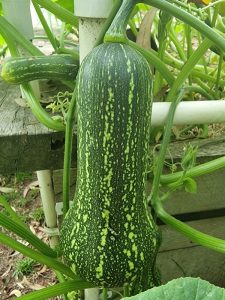It may be pretty but is it tasty? The dangers of cross-pollination
Robin Gale-Baker, from Sustainable Macleod, discusses the dangers of cross-pollination. This is one of a series of articles she has written about growing various veggies (see right hand sidebar). She has also written a number of articles about growing various herbs, growing various fruit trees and general growing techniques.
 As your pumpkins ripen, you may notice that what has grown is not always what you thought you had planted. Have you, for example, ever got a long, green or bluish-striped pumpkin when you thought you had planted a round Kent or even a Queensland Blue? ‘Cross-pollination’ is the culprit, where cross-pollination is when a flower on one plant is fertilised by pollen from another plant.
As your pumpkins ripen, you may notice that what has grown is not always what you thought you had planted. Have you, for example, ever got a long, green or bluish-striped pumpkin when you thought you had planted a round Kent or even a Queensland Blue? ‘Cross-pollination’ is the culprit, where cross-pollination is when a flower on one plant is fertilised by pollen from another plant.
The photo right is of a ‘tromboncino’ grown from saved seed but it looks like that saved seed was the result of cross-pollination between tromboncino and kent pumpkins. Cross-pollination sometimes produces good produce and can be visually attractive. However it is a lottery and you may well find the results bitter or tasteless and the texture, watery or grainy. It seems such a shame to tend to a crop only for this to happen.
Cross-pollination usually relates to the grandparents of a vegetable rather than to its parents. This is because, when cross-pollination occurs, it affects the seeds (which contain DNA from each of the plants) but not the surrounding fruit (which only contains the DNA of the female parent). So, the fruit grows normally but any plants subsequently grown from the seeds within it will have uncertain fruit.
So, cross-pollination will not affect plants in the first season as long as you use commercial seed (which is never cross-pollinated) or the flowers have been bagged and hand-pollinated by you (so the bees and other pollinators have been prevented from accessing the flowers and thus potentially cross-pollinating them). The bees may be buzzing around transferring pollen between closely related family members but in this season the fruit produced will be whatever you planted. For example, if you plant both pumpkin and zucchini, your pumpkin plants in the first season will always produce pumpkins and your zucchini plants, zucchini.
In season two, however, saved seed from season one can contain the genetics of both parent plants and the progeny will be a cross between the two (just as it is in humans). So, seeds from that delicious pumpkin that you grew will be unlikely to give you the same pumpkin in the following season.
Only varieties within a single species can cross. The species Cucurbita pepo is a [prime example. Within this species are pumpkins, zucchinis and squash (such as spaghetti squash). They are closely related and can easily cross-pollinate. By contrast, whilst cucumbers (Cucumis sativa) are in the same family (Cucurbitaceae), they are a different species so will not cross with pumpkins, zucchinis or squash. However cucumber varieties can cross-pollinate with each other.
Other fruits that can cross-pollinate include cantaloupe and honeydew melon (but neither cross with watermelon).
Tomato varieties can in principle cross-pollinate but in practice hardly ever do. Ditto beans, broad beans and peas.
Brassicas are notorious for cross-pollinating if left to flower and to bad effect, often producing a bunch of leaves in place of a heart in hearting vegetables. Cauliflower, cabbage, kale, Brussels sprouts and broccoli can all cross with each other because they are actually all the same species. Ditto the various mustard greens.
Sweetcorn is a special case because the cross-pollination can affect the cob (which is the part that you eat) in the first year. It should therefore be grown in isolation to preventive odd (and usually defective) fruit. Sweetcorn is wind-pollinated so the pollen can travel a long way on a strong wind. That means that one variety must be at least 35 metres from another (but preferably, to be absolutely sure, 1 km apart). It also means that you should check whether your neighbours are growing sweetcorn and determine the variety. Note that popcorn varieties will usually dominate sweet corn varieties.
Bees can travel vast distances – up to 8km – so they can bring pollen to your garden from a wide array of gardens and plant varieties on their travels. Commercial beehives can be a source of seed contamination and there is a withholding period of 7 days for some crops meaning, for example, that beehives which are moved from crop to crop by beekeepers must not be moved from an area where, say, brassicas are growing to another area where other brassicas are growing for 7 days. Rather, the hives would need to be moved to a neutral zone and wait it out.
When you are travelling in the countryside, you may see fully netted areas that provide enclosures with the netting hem weighted down so that no pollinators can enter the isolation area. This is how seed merchants control the genetics of their seed.
If you only ever use commercial seed, then cross-pollination will not be an issue for you. If, however, you are a seed-saver, or you swap seed with friends or select seed from a seed library, then you need to avoid certain seed or run the risk of a disappointing outcome. In other words, don’t save seed for cucurbits (pumpkins, cucumbers, gourds, rockmelons, watermelons, zucchini, etc), brassicas (cauliflower, cabbage, kale, Brussels sprouts, broccoli, etc) or sweetcorn unless you are sure that cross-pollination has not occurred.
